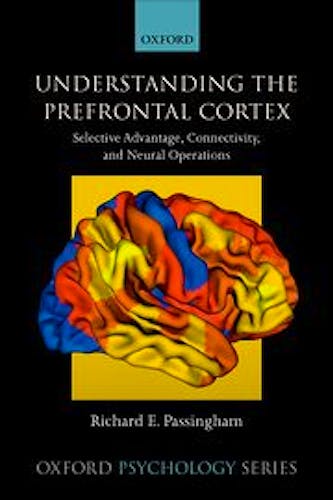

No hay productos en el carrito



Understanding the Prefrontal Cortex. Selective Advantage, Connectivity, and Neural Operations
Passingham, R.
1ª Edición Junio 2021
Inglés
Tapa blanda
528 pags
882 gr
16 x 24 x 3 cm
ISBN 9780198844570
Editorial OXFORD UNIVERSITY PRESS
LIBRO IMPRESO
-5%
61,24 €58,18 €IVA incluido
58,88 €55,94 €IVA no incluido
Recíbelo en un plazo de
2 - 3 semanas
Foundations
1:Introduction
2:The evolution of non-human primate brains
Subareas of the prefrontal cortex
3:Medial prefrontal cortex: self-generated action
4:Orbital prefrontal cortex: Evaluating resources
5:Caudal prefrontal cortex: Searching for objects
6:Dorsal prefrontal cortex: Planning sequences
7:Ventral prefrontal cortex: Associating objects
Prefrontal cortex within the system as a whole
8:Prefrontal cortex: abstract rules, reinforcement and skill
The human brain
9:The evolution of the prefrontal cortex in the hominins
10:Human prefrontal cortex: Reasoning, imagination, and planning
11:Human prefrontal cortex: Communication, mentalizing, and moral rules
A successor to the acclaimed 'Neurobiology of the Prefrontal Cortex', 'Understanding the Prefrontal Cortex' presents a careful study of the anatomical connections in this brain region, showing how each area and subarea of the brain has a unique pattern of connections, and exploring the transformation that this area performs - from its inputs to it outputs.
The book starts with two chapters of foundational material, before considering five subdivisions of the prefrontal cortex, and looking at the transformation that each one performs. Next it considers how the prefrontal cortex interacts with the rest of the brain, including not only cortical areas but also subcortical areas such as the basal ganglia and cerebellum.
The book ends with a final section in which these principles are applied to the human brain. It starts by discussing the expansion of the prefrontal cortex during human evolution. It then considers how the human brain has co-opted mechanisms that existed in our primate ancestors, and by providing new inputs had extended them so as to support reasoning, remembering events from the distant past and imagining events in the distant future, the sense of self, language, the ability to understand the mental states of others, and the ability to cooperate and learn social and moral rules.
Written by a leading brain scientist, the book will be an important and influential contribution to the neuroscience literature.
- Puts forward concrete proposals about the operations that the prefrontal cortex performs
- Written in a lively and clear style, accessible to students and researchers
- A successor to the acclaimed and successful 'Neurobiology of the Prefrontal Cortex'
Professor Richard E. Passingham FRS is Emeritus Professor of Cognitive Neuroscience at the University of Oxford. He was made Professor of Cognitive Neuroscience at Oxford in 1997. In 1996 he moved to the newly founded Wellcome Centre for NeuroImaging at the University of London where he was an Honorary Principal. He was amongst the first to use brain imaging to study human cognition, starting in 1988 at the MRC Cyclotron Unit at the Hammersmith Hospital where he was an Honorary Senior Lecturer. He was made a University Lecturer and Fellow of Wadham College, Oxford in 1976. He received his BA from the University of Oxford and his Ph.D in Psychology from the University of London.
Reviews
If you want to understand the frontal lobes of the brain then there is no better guide than this. It covers both the very latest research and the seminal studies that have shaped the field. Not only does it integrate what we know about the patterns of activity that play across prefrontal neurons with neuroimaging research but it is informed by a deep understanding of anatomy and evolution. There is nothing else quite like it. - Matthew Rushworth FRS, Watts Professor, Department of Psychology and Wellcome Centre for Integrative Neuroscience (WIN), University of Oxford
A wonderful, authoritative, book on the most human region of the brain. All told from the perspective of its “geography”. It is a major update and will be a rich resource for years to come.' - Earl Miller, Picower Professor of Neuroscience, MIT
© 2026 Axón Librería S.L.
2.149.0